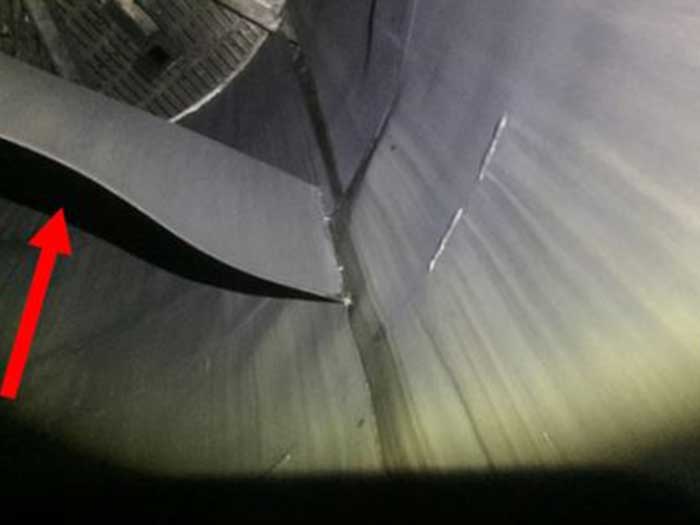
Gard reports on lessons learned from scrubber claims
Written by Nick Blenkey
An example of poor shipyard work during scrubber retrofit: Deformed plates and buckled scrubber housing
A loss prevention note from mutual insurer Gard says that nearly 3,000 vessels will have exhaust gas scrubbers installed by 2020. For the majority of owners and crews, scrubber systems are new technology and, as with any new system, teething problems can be expected. Gard says it has handled a few scrubber related claims and the loss prevention article looks at some of these cases
Fire during retrofitting of scrubber
Scrubber installation requires extensive hot work to facilitate the extension of the funnel area and attaching the scrubber tower to the vessel’s structure.
Gard has seen a few fire incidents where sparks from welding, metal cutting, and other hot work activities fell into the inner chamber of the scrubber through uncovered openings, and in one case the fire also spread to the engine room through glass reinforced epoxy (GRE) piping. Heat generated from the steel cutting for the supporting brackets, also contributed to the build up of heat inside the scrubber. In all these cases the yard fire fighting team responded and extinguished the fire with vital assistance from crew.
Later investigations revealed that crew had requested that the shipyard cover the openings but this was not done. The fire risk to scrubber packing during the hot work activity had not been identified by yard personnel, and many of them were not aware that internal components of the scrubber were combustible. These fire incidents arising from shortcomings in hotwork safety procedures are not peculiar to scrubbers and can occur in any location onboard a ship where welding, cutting or grinding works are undertaken.
Sea water ingress due to corrosion
Scrubber waste is corrosive, and Gard has seen a few incidents where within 10-15 months of the open loop scrubber being installed, corrosion of overboard distance piece or in its immediate vicinity has resulted in water ingress into areas such as the engine room, ballast tanks and cargo holds. Absence of or poor application of protective coatings on the inside of the pipe and at the welds, along with poor application of paint on hull plating near the washwater discharge were identified as the causes of accelerated corrosion. In all these cases, temporary repairs to plug the leak were carried out by divers followed by permanent repairs at a yard.
Scrubber damage due to poor workmanship and thermal shock
A vessel was regularly trading in Northern Europe and had installed an open loop scrubber. It had to changeover to low sulfur fuel when visiting a port that had regulations in place banning discharge of washwater from open loop scrubbers. It was still required to run the scrubber in dry mode, i.e. with washwater supply pumps turned off, to allow for the passage of hot exhaust gasses with a temperature of nearly 400° C. After departure from port, washwater pumps would be started and cold sea water sprayed through the nozzles inside the scrubber. During inspection of the scrubber by crew, damage was noticed to the nozzles, demister housing and the drains.
A survey was carried out and indicated a variety of concurrent causes, such as thermal shock, poor workmanship by the yard, for example, only spot welding done on demister supporting plates; and poor design. The scrubber had been in service for nearly two years.
Recommendations
Gard’s loss prevention article gives a number of recommendations on how to avoid these sorts of problem. You can access it HERE




